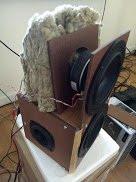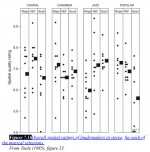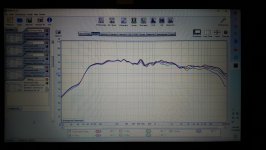Dont buy active studio monitors. They are meant for near field analytic listening to detect faults in the recording and gives little pleasure. You will hate most music sounding harsh and fatigue with no bass but booming 100Hz. I’ve learned this the hard way with Genelecs, Yamahas and what not. I think Kef and Dynaudio have some nice active small hifi stuff going on though but why go active if you have amp? Why not build yourself?
Genelecs, one of the flatest EQ speakers have no bass and booming 100hz ? Sounds like you have a problem with your room. Yea if you don't want to hear whats in the recording don't get studio monitors.
This seems way too generalized to be accurate across the board.Dont buy active studio monitors. They are meant for near field analytic listening to detect faults in the recording and gives little pleasure. You will hate most music sounding harsh and fatigue with no bass but booming 100Hz. I’ve learned this the hard way with Genelecs, Yamahas and what not. I think Kef and Dynaudio have some nice active small hifi stuff going on though but why go active if you have amp? Why not build yourself?
Genelecs, one of the flatest EQ speakers have no bass and booming 100hz ? Sounds like you have a problem with your room. Yea if you don't want to hear whats in the recording don't get studio monitors.
My experience is based on trying 8020, 8030, 8040 some years back before the DSP versions came as well as Yamaha HS50/80 compared to some Tannoy hifi passives. In general the bigger the better was what I found but the price is exponential, yet I always preferred the much cheap Tannoys for listening. But yes room/placement is an issue with near fields almost always being close to the wall and on a desktop. They have options for adjusting that but sitting 3m away I think the problem would be harshness more than anything. Sorry if this came of too generalized. I just dont think the OP is looking for active near fields.
Last edited:
There are no not-nearfield monitors. All monitoring is done nearfield AFAIK. One could argue that loudspeakers with directivity control on the high driver are nearfields. The reason is that outside the controlled beam, the frequency response goes into all directions. So for general use, that might not be optimum.
Near fields usually have a very prominent mid range and highs and can fatigue over time due to the missing lows (depends on size of course), they present all the flaws in the mix, much like a magnifying glass. They are usually designed for a specified loudness level and the frequency response are flat on that level making it less adjusted to the FM curves meaning they could be harsh on lower levels and give little pleasure. Main monitors on the other hand are more SPL, dynamics, often big 3-way full ranges pleasing to the client on distance, sometimes much like PA (15”+horn) fun to listen for shorter time to test the mix how it would behave in a club. I believe that both cases differs from Hi-Fi which is more about pleasing smooth sound on all type of music over a long time at any level. Of course this is a preference thing. But the higher the price the less these different types of speakers differ meaning they come closer. But for 1000$ one need consider what is important: Loud SPL/big sound (PA style), analytic mids (near field style), or a pleasing listening experience (Hi-Fi). What is the accepted compromises. Of course this post is generalized but this is my experience with near fields specifically. I’m sure there are near fields out there suitable for hifi and visa versa but if you want active consider rather ie Dynaudio Focus 110 rather than BM6. Compare them and you will understand what I mean.
Last edited:
Tannoy Sensys DC1. My other speakers are Tannoy Saturn and vintage Tannoy Eatons both with re-designed xovers and additional cabinet treatment. The Sensys DC1 sound correct out of the box but need cabinet treatment with Dynamat. Coaxials seem to be forgiving in terms of placement. I have also heard Hsu Research coaxials which were very good. KEF should also be on the list.
The Eaton drivers are 10 inch, but the smaller Sensys DC1 give them a run for the money.
The Eaton drivers are 10 inch, but the smaller Sensys DC1 give them a run for the money.
Ah yes Tannoy dual concentrics are truly nice for the most part.
I enjoy the Saturn S8LCR yet they are very dark but super smooth and tons of body and dynamics, mid a little cluttered. Revolution DC6T even better mids but struggle from what most floorstanders do in the 200Hz area. DC4 not so much, they are just harsh. XT mini great, however totally surprised by those. It’s a hit and miss but some of the lower priced bookshelf Tannoys are really great. My biggest surprise was when I brought my old 250$ Profile 631SE and realized they outperform the 700$ Genelec 8020 in terms of enjoyment. I’d love to test the new Eaton and Gold 8 and maybe the latest 12” PAs they have and compare. I don’t have that money though so DIY solves it for me. I think 1000 is where DIY outperform mass produced.
I enjoy the Saturn S8LCR yet they are very dark but super smooth and tons of body and dynamics, mid a little cluttered. Revolution DC6T even better mids but struggle from what most floorstanders do in the 200Hz area. DC4 not so much, they are just harsh. XT mini great, however totally surprised by those. It’s a hit and miss but some of the lower priced bookshelf Tannoys are really great. My biggest surprise was when I brought my old 250$ Profile 631SE and realized they outperform the 700$ Genelec 8020 in terms of enjoyment. I’d love to test the new Eaton and Gold 8 and maybe the latest 12” PAs they have and compare. I don’t have that money though so DIY solves it for me. I think 1000 is where DIY outperform mass produced.
Last edited:
And now for something completely different...
I have a pair of ProAc Super Tablettes coming.
We'll see how they perform. I am going to see if they measure up and if there are any tweaks available. First thing may be to replace all the crossover caps with Mundorf Evo's.
I have a pair of ProAc Super Tablettes coming.
We'll see how they perform. I am going to see if they measure up and if there are any tweaks available. First thing may be to replace all the crossover caps with Mundorf Evo's.
Near fields usually have a very prominent mid range and highs and can fatigue over time due to the missing lows (depends on size of course), they present all the flaws in the mix, much like a magnifying glass. They are usually designed for a specified loudness level and the frequency response are flat on that level making it less adjusted to the FM curves meaning they could be harsh on lower levels and give little pleasure. Main monitors on the other hand are more SPL, dynamics, often big 3-way full ranges pleasing to the client on distance, sometimes much like PA (15”+horn) fun to listen for shorter time to test the mix how it would behave in a club. I believe that both cases differs from Hi-Fi which is more about pleasing smooth sound on all type of music over a long time at any level. Of course this is a preference thing. But the higher the price the less these different types of speakers differ meaning they come closer. But for 1000$ one need consider what is important: Loud SPL/big sound (PA style), analytic mids (near field style), or a pleasing listening experience (Hi-Fi). What is the accepted compromises. Of course this post is generalized but this is my experience with near fields specifically. I’m sure there are near fields out there suitable for hifi and visa versa but if you want active consider rather ie Dynaudio Focus 110 rather than BM6. Compare them and you will understand what I mean.
It sounds like you have a pro audio background. In which case I can see why you are concerned about near field monitors. You work in big spaces. But in a residential sized room we listen at close distances.
That's also why we don't need low frequencies in our two main channel speakers. In a small room we want separate sources for low frequencies so we can position them independently from the two main channels because we have to contend with room modes.
Today's active speakers have superior control over the frequency range. With bi-amplification and DSP you can fit an ideal frequency response curve.
Drawbacks to active studio monitors in the home setting are the pro-audio terminals and legacy home theater receivers that don't have pre-outs to bypass their amplifiers.
My "studio" is 10-12m2 so not large at all. But I have two listening positions. One at the desk (working position), the other one at the couch behind. Also I listen a lot in living room which is 25m2. I try all my speakers at all positions in both rooms and note down my experience with them.It sounds like you have a pro audio background. In which case I can see why you are concerned about near field monitors. You work in big spaces. But in a residential sized room we listen at close distances.
When I mix/do studio work I monitor from 1m distance. And the purpose is to detect flaws and get a good balance of the mix (avoid harshness in mix), and to do so I need a fixed SPL level and flat response at 1m and I need to really know the speaker to predict the end result. I use Genelec 8020 for this application now. I am not so happy with them but struggle to find good replacement in the accepted price ringe. I do consider the new Tannoy Gold 7 or 8.
When I listen to music I am typically 3-5m away and prefer also a very different tone balance, less fatigue more smooth (to be more exact I prefer a -3dB dip around 3,5-5kHz, and a rice in 100Hz and below). Decent dynamics is more crucial for the pleasing result over long sessions in my experience. Tannoys seems to work best for me but I am now in the process of trying some different DIY designs, coax/PA/12"/horns (studio mains) and what not and it seems to be a good direction for me.
Whether these individual speaker applications are based on active, passive, big/large, loud or quiet, 2-way/3-way, dsp or not, and of course cost will have everything to say in the end result to me and how flexible they are across the applications. But cost/use ratio is important. I'm not looking for perfect. I look for good enough (80% is my life motto), and preferably somewhat cross application speakers so they have multi-purpose.
Its not easy but luckily its fun. studio and hifi are two very different needs and the vendors know this and adapt their products likewise to the market need, especially for product under $1000 a lof of compromises must be made. You cant have it all. Yet the search itself is the goal for me.
Today's active speakers have superior control over the frequency range. With bi-amplification and DSP you can fit an ideal frequency response curve.
This is a very good point, active speakers have for the most part a big benefit, especially recent years with DSP.
Still there is a difference in how vendors tune their active xo in products to hifi and studio markets, that's why I brought up the Dynaudio Focus 110A and BM6A comparisons, they are essentially the same speaker but with very different tuning/tone and hence different application.
At 3-5m distance hifi listening, the 110 is for most audiophiles superior.
At 1m studio application the BM6A is for most musicians superior.
They are very different speakers yet the design is almost identical, its all in the tone tuning in the xo. For more expensive speakers, 3-ways, actives with DSP, large bass there differences are washed out and the applications merge into each other.
I think both studio engineers and audiophiles will love the Genelec 8260A at any listening position and level as they are truly transparent full range flat response. Even the PA dudes may like it due to its extreme clear dynamic and presentation. But its ugly as hell, cost a fortune and to most not at all worth it.
Drawbacks to active studio monitors in the home setting are the pro-audio terminals and legacy home theater receivers that don't have pre-outs to bypass their amplifiers.
There are RCA/XLR converters out there not really a problem but yet a pre-amp/dac is needed for simple things as volume control and input selector. For hifi I still prefer traditional integrated amps and passive xos tuned for pleasing results.
Active DSP hifi speakers could be a hit and miss in the marked really.
Yes there are great potential but who will buy these, other than studio guys looking for a smoother tone? Power cables all over isn't attractive either.
I think the DIY aspect of it is much better (external DSP amps, easy replaceable), but then youre an enthusiast combining studio, hifi, and PA application all in one. But we belong to the nut house.
At OP, let us know how those ProAC works for you, 13 years in the search I hope you get that sound you look for 🙂
Last edited:
I am now in the process of trying some different DIY designs, coax/PA/12"/horns (studio mains) and what not and it seems to be a good direction for me.
I'm using DSP to experiment with a midrange module where waveguides/horns are impractical because they get too large. Active noise cancelling from 150Hz to 500Hz then a transition to cardioid/dipole up to 1,000Hz. None of that is settled because I'm experimenting. I might wind up with active noise cancelling all the way to 1,000Hz.
I'm designing it for HiFi listening not music editing. But, I can turn the active noise cancelling on and off as well as shift the frequencies around because it is DSP. If I wanted to hear the mid-bass region clearly -- or listen for flaws that might be masked by lower frequencies -- I'd turn on noise cancelling. If I wanted to hear what a typical speaker sounded like in that region I'd turn off the noise cancelling. The neat thing is the ability to do it on the fly.
I'm going to build a flexible module above 1,000Hz as well. The reason I am creating flexible modules is because Floyd Toole demonstrated how different styles of music sound better or worse with different types of directivity.
I'm not suggesting doing any of this because I have no idea how to edit music. And it might be ridiculous in the context or creating music rather than listening.
Attachments
How did u like the Klipsch RB-81? Did you try the RP-600M BOOKSHELF SPEAKERS? In piano finish for 439$/pair , I think they are a bargain .
Last year I bought from Adorama.com a pair of Polk Audio LSi M703 for 400$/pair. These are incredible , the cabinets are ridiculous beautiful and they sound amazing.
I would like to hear Polk Audio Legend L200 .
Last year I bought from Adorama.com a pair of Polk Audio LSi M703 for 400$/pair. These are incredible , the cabinets are ridiculous beautiful and they sound amazing.
I would like to hear Polk Audio Legend L200 .
A friend of mine dropped his bookshelf speakers at my place. Sony ss-cs5. Three way with two domes and small midbass. I listen to them, i like what i hear. I measured them, they have impeccable spec, ruler flat response and great of axis behavior.
They need sub though.
They need sub though.
Sony SS-CS5 3-way Speaker Review | Audio Science Review (ASR) ForumA friend of mine dropped his bookshelf speakers at my place. Sony ss-cs5. Three way with two domes and small midbass. I listen to them, i like what i hear. I measured them, they have impeccable spec, ruler flat response and great of axis behavior.
They need sub though.
Just from the photo I knew the vertical off-axis was going to be garbage. Why have a 3/4" tweeter with a 1" tweeter, and at a substantial c-c distance no less?
Sony SS-CS5 3-way Speaker Review | Audio Science Review (ASR) Forum
Just from the photo I knew the vertical off-axis was going to be garbage. Why have a 3/4" tweeter with a 1" tweeter, and at a substantial c-c distance no less?
are you listening vertically?
- Home
- Loudspeakers
- Multi-Way
- What's the best pair of bookshelf speakers for under $1000?


